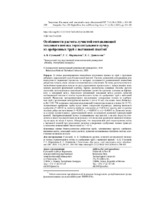| dc.contributor.author | Сухоцкий, А. Б. | |
| dc.contributor.author | Маршалова, Г. С. | |
| dc.contributor.author | Данильчик, Е. С. | |
| dc.coverage.spatial | Минск | ru |
| dc.date.accessioned | 2020-08-07T11:07:08Z | |
| dc.date.available | 2020-08-07T11:07:08Z | |
| dc.date.issued | 2020 | |
| dc.identifier.citation | Сухоцкий, А. Б. Особенности расчета лучистой составляющей теплового потока горизонтального пучка из оребренных труб с вытяжной шахтой = Specific Features of Calculating the Radiant Component of the Heat Flow of Horizontal Bunch from Finned Tubes with Exhaust Shaft / А. Б. Сухоцкий, Г. С. Маршалова, Е. С. Данильчик // Энергетика. Известия высших учебных заведений и энергетических объединений СНГ. – 2020. – № 4. – С. 380-388. | ru |
| dc.identifier.uri | https://rep.bntu.by/handle/data/77509 | |
| dc.description.abstract | В статье рассматривается теплообмен излучением пучков из труб с круглыми ребрами с окружающей средой и вытяжной шахтой. Система уравнений, описывающая всю совокупность первичных процессов, из которых складывается радиационный теплообмен ребристых пучков, очень сложна в математическом отношении. Поэтому расчеты лучистого теплообмена проводятся исходя из ряда упрощающих предпосылок с вынужденным искажением реальной физической картины. Кратко рассмотрены основные способы расчета излучения, используемые в инженерной практике: расчет по среднему угловому коэффициенту и зональный метод. Предложен уточненный зональный метод расчета лучистой составляющей теплового потока горизонтального пучка из оребренных труб с вытяжной шахтой. Проведено экспериментальное исследование однорядных пучков из оребренных труб с различными межтрубными шагами S1 (64 и 70 мм) для малых чисел Рейнольдса Re = 130−720 в широком диапазоне определяющей температуры на входе в пучок (16−83 °C). Алюминиевое оребрение трубы пучка имеет следующие параметры: диаметр винтового оребрения d = 0,0568 м; диаметр трубы по основанию d0 = 0,0264 м; высота, шаг и средняя толщина ребра соответственно h = 0,0152 м, s = 0,00243 м и Δ = 0,00055 м. Движение воздуха в пучке осуществлялось гравитационной тягой, создаваемой вытяжной прямоугольной шахтой. Экспериментальный пучок устанавливался над шахтой, а воздух перед поступлением в шахту предварительно подогревался, что позволило расширить диапазон температур воздуха на входе в пучок. Обнаружено, что неправильный учет переизлучения пучка с вытяжной шахтой при проведении расчетов однорядных оребренных пучков приводит к снижению конвективной теплоотдачи на 7−25 %. | ru |
| dc.language.iso | ru | ru |
| dc.publisher | БНТУ | ru |
| dc.title | Особенности расчета лучистой составляющей теплового потока горизонтального пучка из оребренных труб с вытяжной шахтой | ru |
| dc.title.alternative | Specific Features of Calculating the Radiant Component of the Heat Flow of Horizontal Bunch from Finned Tubes with Exhaust Shaft | ru |
| dc.type | Article | ru |
| dc.identifier.doi | 10.21122/1029-7448-2020-63-4-380-388 | |
| local.description.annotation | The article discusses the heat exchange of radiation of bunches of round finned tubes with the environment and the exhaust shaft. The system of equations describing the entire set of primary processes that make up the radiation heat exchange of finned bundles is very complex mathematically; therefore, the calculations of radiant heat transfer are usually based on a number of simplifying assumptions with a involuntarily distortion of the real physical picture. The main methods for calculating radiation used in engineering practice, viz. calculation by the average angular coefficient and the zonal method are briefly considered. A refined zonal method for calculating the radiant component of the heat flow of a horizontal bunch of finned tubes with an exhaust shaft is proposed. An experimental study of single-row bunches of finned tubes with different annular steps S1 (64 and 70 mm) was carried out for small Reynolds numbers Re = 130–720 in a wide range of the determining temperature at the beam inlet (16–83 °C). The aluminum finning of the bunch tube had the following parameters: screw finning diameter d = 0.0568 m; diameter of the tube at the base d0 = 0.0264 m; height, step and average fin thickness, respectively, h = 0.0152 m, s = 0.00243 m and Δ = 0.00055 m. Air movement in the bunch was carried out by gravitational traction created by a rectangular exhaust shaft. The experimental bunch was installed above the shaft, and the air was preheated before entering the shaft, which allowed expanding the temperature range of the air at the entrance to the bunch. It was found that incorrect accounting for a bunch reemission with an exhaust shaft when calculating single-row finned bunches causes a decrease in convective heat transfer by 7–25 %. | ru |

